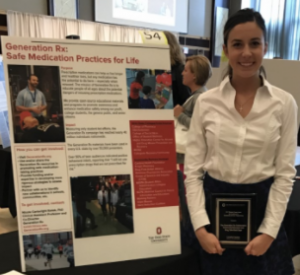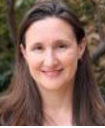
By: Marie Latsa
“Ohio #1 in the nation for overdose deaths” read the billboard near The Ohio State University’s campus. “Generation Rx Night at the Columbus Blue Jackets Game” read a flyer in the hallway of Parks Hall. Amazing Grace sang by nearly two hundred student pharmacists during a candlelight vigil in remembrance of those who have lost their battle to the disease of addiction. “Drug Take Back Day: Going on Now!” read a news segment headline on 10TV news. “Absolutely, I’ll be there,” stated a reply email from Councilman Stinziano when asked to collaborate for a Generation Rx teen toolkit presentation at Metro Early College High School.
 Student pharmacists at The Ohio State University College of Pharmacy have been busy the past academic year educating the community about the misuse of prescription medications. In fact, we calculated an estimate of 91,573 people had in some way, shape or form been exposed to our promotional materials from January 2016 through April 2017. Throughout the course of the aforementioned timeline students gave a total of 17 Generation Rx presentations utilizing toolkits off of the generationrx.org website and conducted 18 non-presentation events such as working a booth at a local health fair, volunteering at The Pharmathon 5k in coordination with The Alumni Association or conducting a medication safety summer camp for kids.
Student pharmacists at The Ohio State University College of Pharmacy have been busy the past academic year educating the community about the misuse of prescription medications. In fact, we calculated an estimate of 91,573 people had in some way, shape or form been exposed to our promotional materials from January 2016 through April 2017. Throughout the course of the aforementioned timeline students gave a total of 17 Generation Rx presentations utilizing toolkits off of the generationrx.org website and conducted 18 non-presentation events such as working a booth at a local health fair, volunteering at The Pharmathon 5k in coordination with The Alumni Association or conducting a medication safety summer camp for kids.
 Most recently, The Generation Rx Collaborative was recognized on the university level by The Office of Student Life for Excellence in Community Service Programming. None of our successes could’ve been obtained without the guidance of our mentors Dr. Hale and Dr. Kwiek, some resourcefulness, positivity, and, quite truthfully, a little bit of dumb luck. We would like to take the time to thank each and every one of our supporters for not only believing in us as student pharmacists but also in our cause: namely Lamar Advertising, The Columbus Blue Jackets, 10TV News, and The Lantern. We are humbled and thankful for a tremendous year, but know that our work is far from finished with regard to the opioid epidemic.
Most recently, The Generation Rx Collaborative was recognized on the university level by The Office of Student Life for Excellence in Community Service Programming. None of our successes could’ve been obtained without the guidance of our mentors Dr. Hale and Dr. Kwiek, some resourcefulness, positivity, and, quite truthfully, a little bit of dumb luck. We would like to take the time to thank each and every one of our supporters for not only believing in us as student pharmacists but also in our cause: namely Lamar Advertising, The Columbus Blue Jackets, 10TV News, and The Lantern. We are humbled and thankful for a tremendous year, but know that our work is far from finished with regard to the opioid epidemic.
As for me, I am currently sitting in my room in my modest off-campus apartment with a purple carry-on stuffed to the brim and a cup of tea at my bedside. I will be taking that same purple carry-on with me tomorrow morning at 06:00 as I depart for Salt Lake City, Utah for the chance to attend The APhA Institute on Alcoholism and Drug Dependencies. How fitting it is for a cause that has been such a large part of past five years of my academic career to lead me into my fourth and final year of pharmacy school. It’s times like these when I wonder what I did to deserve the people and opportunities I’ve encountered at Ohio State. I am certain, though, that I am forever thankful.
 Marie Latsa is a current fourth-year Doctor of Pharmacy Candidate at The Ohio State University College of Pharmacy. She served as Co-President of The Generation Rx Collaborative for the 2016-2017 academic year, but has been involved with Generation Rx since 2013. She will continue to work as a student lab assistant at The Generation Rx Lab at COSI throughout the duration of her academic career. Marie aspires to pursue a career in academia.
Marie Latsa is a current fourth-year Doctor of Pharmacy Candidate at The Ohio State University College of Pharmacy. She served as Co-President of The Generation Rx Collaborative for the 2016-2017 academic year, but has been involved with Generation Rx since 2013. She will continue to work as a student lab assistant at The Generation Rx Lab at COSI throughout the duration of her academic career. Marie aspires to pursue a career in academia.



















